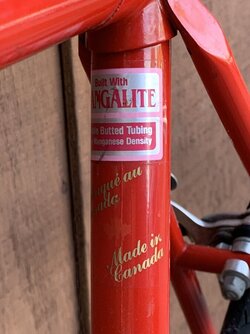flopner
Senior Member
Hi;
I have this 1983 Peugeot PB14 I want to repaint . It is made in Canada and has a mangalite tubing sticker on it. The catalogs I looked at for 1983 show a PB12 in the Canadian catalog and the PB14 in the U.S. catalog. The PB12 was sold in Canada and has Reynolds 501 tubing and the PB14 was sold in the U.S. and has "Mangalite". The bikes both come from the same factory which is Procycle of Quebec. The bikes both have the same simplex forged dropouts and same lug set and same forged fork crown.
I tried to find some information on this "mangalite" tubing and there isn't any to be had , no record of anyone manufacturing that and that is kinda weird. Also the Mangalite sticker doesn't look very professional , like some local shop made them and there isn't any info on it other than "Mangalite" and "double butted".
So since the PB12 sold in Canada and the PB14 sold in the U.S. are pretty identical I wonder if the mystery tubing is actually reynolds 501 and was labeled that way for some unknown reason.
When I repaint I can still get a reynolds 501 decal and I don't think I would feel guilty putting it on the bike.
Anyone know anything more about this mystery "mangalite" tubing?
I have this 1983 Peugeot PB14 I want to repaint . It is made in Canada and has a mangalite tubing sticker on it. The catalogs I looked at for 1983 show a PB12 in the Canadian catalog and the PB14 in the U.S. catalog. The PB12 was sold in Canada and has Reynolds 501 tubing and the PB14 was sold in the U.S. and has "Mangalite". The bikes both come from the same factory which is Procycle of Quebec. The bikes both have the same simplex forged dropouts and same lug set and same forged fork crown.
I tried to find some information on this "mangalite" tubing and there isn't any to be had , no record of anyone manufacturing that and that is kinda weird. Also the Mangalite sticker doesn't look very professional , like some local shop made them and there isn't any info on it other than "Mangalite" and "double butted".
So since the PB12 sold in Canada and the PB14 sold in the U.S. are pretty identical I wonder if the mystery tubing is actually reynolds 501 and was labeled that way for some unknown reason.
When I repaint I can still get a reynolds 501 decal and I don't think I would feel guilty putting it on the bike.
Anyone know anything more about this mystery "mangalite" tubing?

